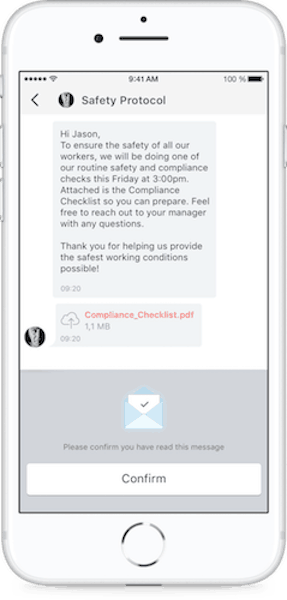
By Jodi Beaubien
Though it varies depending on the industry and the unique functions of the work performed, companies and HR professionals in particular continue to face challenges around communicating effectively with unionized labor or in hybrid union and non-union environments. One of the biggest obstacles is encapsulated by this key question: how do we effectively track if employees are reading and receiving the mission-critical information we send?
As an employer, there is certain information required by law to deliver to employees. It is your obligation to ensure your workforce receives said information during compensable time. Bulletin boards and other modes of information-sharing, such as emails, are not always effective or available methods to communicate. Hourly laborers often don’t have access to corporate email, computer or the nature of work prevents them from receiving timely communication.
Therefore, it is imperative to ensure your workforce has access to crucial content, such as OSHA guidelines, policy/procedural updates, SOP guides, payroll updates, or product changes in common ways, which are typically found in the following areas or circumstances:
- With employee timecards or within a payslip envelope
- Notices posted in areas where time-card punching occurs
- Digital signage boards posted throughout commonly-trafficked employee areas, such as break rooms, warehouses, and production facilities
The Origin of Unions and the Associated Impact on Workplace Communication
Enacted in the 1930s to protect employees, the National Labor Relations Board (NLRB) began from a noble premise but in modern times has unfortunately contributed to the emergence of an ostracized environment for the employer. Employers have become timid due to fear of violating union favored guidelines, thus employers take a hands-off approach when it comes to internal communication in the workplace. In addition, HR must contend with and cater to different classifications of employees: part-time, full-time, exempt, and non-exempt.
The bottom line? All of these conversations require different information delivery methods based on geo-specific labor regulations.
This requires organizational leaders, especially HR, to make sure these different groups get the information they need, even if the work they perform is segmented. As is often the case, the “problem child” gets the most attention, and other just as important groups get neglected as a result. This contributes to a trickle down effect across an entire organization that has consequences such as turnover and a decrease in overall employee engagement.
Streamline Communication Methods to Reach Every Department
Having to communicate company messaging to multiple groups requires more time from every department, not just HR. It is inefficient because of the risk of over-communicate to everyone if messaging is delivered outside of the method the employee prefers to receive it. Given that over 77% of adults in the U.S. own smartphones, solutions include adopting a BYOD (bring your own device) policy to accommodate the majority of the workforce that likely owns a mobile device. There are a multitude of relevant reasons to implement a mobile communication tool, but above all, HR professionals need to consider where and how company information is being posted. In unionized environments, companies can’t communicate with employees during non-compensable time.
Think of it this way: with a mobile communication and productivity platform, you are allowing employees to have a choice in how they receive required and essential information about their jobs––and this choice aspect is paramount. BYOD policies are largely successful precisely because the delivery mechanism gives your employees a familiar way to receive information, one that mirrors how they are already communicating in their daily lives.
Internal Communication Strategies for Unionized Workforces
If you’re communicating with a union employee, it is imperative that employee has access to work information during compensable time. If the content being communicated is a requirement in order to perform work, technology can supplement how and where an employee can access information by providing a digital resource for information in addition to providing it in a primary and stationary location on the job site.
Again, when digital communication is optional, and paired with an intentional BYOD policy, employees will ultimately elect to participate because they are provided with relevant, useful information as well as vital resources to accomplish their job requirements.
In a hospitality setting, need-to-know content that compels employees to participate might include:
- Critical guest updates
- Instant maintenance reporting and follow-up
- Payroll materials available digitally
- Housekeeping tasks
- Front-of-house operations
- All staff transparency
- Schedules
- Shift swapping
- Employee recognition
For manufacturing teams, a mobile communication solution offers the opportunity for:
- Streamlined digital records ie: equipment manuals and maintenance resources
- Repository for OTJ frequently asked questions
- Safety: Maintaining a continuous production floor presence
- Effectively accomplishing timelines
- Incident record keeping and reporting
- Sharing worksite updates
- Circulating knowledge and best practices
I like to think of optimal digital communication technology as analogous to a drive-thru at a fast food restaurant: while some might take the time to go into the building, they also want the option of a faster delivery method. When companies shift from a “voluntold” mindset to one that is truly optional and clearly conveys value when it comes to effectively communicating, employees are more likely to be not only be on board but also more involved.


